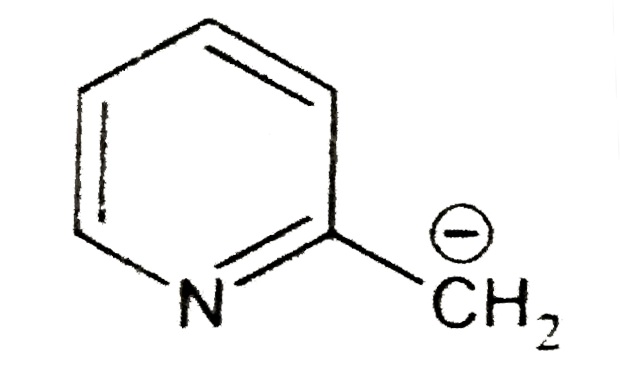The maximum number of no bond resonating structure is possible in
CH3−⊕CH2
H3C−⊕CH−CH3
C2H5−CH3∣C⊕−CH3
H3C−CH3∣C⊕−CH3
To determine the maximum number of no-bond resonating structures (also known as hyperconjugation) possible in the given compounds, we will analyze each compound step by step.
Step 1: Understand No-Bond Resonating Structures
No-bond resonating structures are formed when sigma electrons (from sigma bonds) can delocalize into adjacent pi orbitals. This phenomenon is often referred to as hyperconjugation. The number of no-bond structures is directly related to the number of hydrogen atoms (or sigma bonds) attached to the carbon atoms adjacent to a positively charged carbon.
Step 2: Analyze Each Compound
Compound 1: CH3-CH2-CH2^+
1. The structure can be represented as CH3-CH2-CH^+.
2. The positive charge on the carbon allows for delocalization of sigma electrons from the adjacent CH2 and CH3 groups.
3. There are 3 hydrogen atoms on the CH3 group and 2 on the CH2 group, giving a total of 3 no-bond resonating structures.
Hint: Count the number of hydrogen atoms attached to the carbons adjacent to the positively charged carbon.
Compound 2: CH3-CH^+-CH3
1. The structure can be represented as CH3-CH^+-CH3.
2. The positive charge is on the central carbon, allowing for delocalization from both CH3 groups.
3. There are 6 hydrogen atoms (3 from each CH3), leading to 6 no-bond resonating structures.
Hint: Look for adjacent carbon atoms with hydrogen atoms that can contribute to hyperconjugation.
Compound 3: CH3-CH2-C^+-CH3
1. The structure can be represented as CH3-CH2-C^+-CH3.
2. The positive charge is on the central carbon, allowing for delocalization from the CH3 and CH2 groups.
3. There are 3 from CH3, 2 from CH2, and 3 from the other CH3, totaling 8 no-bond resonating structures.
Hint: Sum the hydrogen atoms from all adjacent groups to find the total number of no-bond structures.
Compound 4: CH3-C^+(CH3)-CH3
1. The structure can be represented as CH3-C^+(CH3)-CH3.
2. The positive charge is on the central carbon, allowing for delocalization from the three CH3 groups.
3. There are 9 hydrogen atoms (3 from each CH3), resulting in 9 no-bond resonating structures.
Hint: Consider all substituents around the positively charged carbon and count their hydrogen atoms.
Step 3: Conclusion
After analyzing all four compounds, we find:
- Compound 1 has 3 no-bond structures.
- Compound 2 has 6 no-bond structures.
- Compound 3 has 8 no-bond structures.
- Compound 4 has 9 no-bond structures.
Thus, the maximum number of no-bond resonating structures is found in Compound 4 (CH3-C^+(CH3)-CH3), which has 9 no-bond resonating structures.
Final Answer
The maximum number of no-bond resonating structures is 9 (in Compound 4).
---
No-bond resonating structures are formed when sigma electrons (from sigma bonds) can delocalize into adjacent pi orbitals. This phenomenon is often referred to as hyperconjugation. The number of no-bond structures is directly related to the number of hydrogen atoms (or sigma bonds) attached to the carbon atoms adjacent to a positively charged carbon.
1. The structure can be represented as CH3-CH2-CH^+.
2. The positive charge on the carbon allows for delocalization of sigma electrons from the adjacent CH2 and CH3 groups.
3. There are 3 hydrogen atoms on the CH3 group and 2 on the CH2 group, giving a total of 3 no-bond resonating structures.
1. The structure can be represented as CH3-CH^+-CH3.
2. The positive charge is on the central carbon, allowing for delocalization from both CH3 groups.
3. There are 6 hydrogen atoms (3 from each CH3), leading to 6 no-bond resonating structures.
1. The structure can be represented as CH3-CH2-C^+-CH3.
2. The positive charge is on the central carbon, allowing for delocalization from the CH3 and CH2 groups.
3. There are 3 from CH3, 2 from CH2, and 3 from the other CH3, totaling 8 no-bond resonating structures.
1. The structure can be represented as CH3-C^+(CH3)-CH3.
2. The positive charge is on the central carbon, allowing for delocalization from the three CH3 groups.
3. There are 9 hydrogen atoms (3 from each CH3), resulting in 9 no-bond resonating structures.
After analyzing all four compounds, we find:
- Compound 1 has 3 no-bond structures.
- Compound 2 has 6 no-bond structures.
- Compound 3 has 8 no-bond structures.
- Compound 4 has 9 no-bond structures.
The maximum number of no-bond resonating structures is 9 (in Compound 4).
Topper's Solved these Questions
- ORGANIC CHEMISTRY : SOME BASIC PRINCIPLES AND TECHNIQUES BOOK - AAKASH INSTITUTE ENGLISHCHAPTER - ORGANIC CHEMISTRY : SOME BASIC PRINCIPLES AND TECHNIQUES EXERCISE - Assignment(SECTION-A)
68 Videos
- ORGANIC CHEMISTRY : SOME BASIC PRINCIPLES AND TECHNIQUES BOOK - AAKASH INSTITUTE ENGLISHCHAPTER - ORGANIC CHEMISTRY : SOME BASIC PRINCIPLES AND TECHNIQUES EXERCISE - Assignment(SECTION B)
6 Videos
- ORGANIC CHEMISTRY : SOME BASIC PRINCIPLES AND TECHNIQUES BOOK - AAKASH INSTITUTE ENGLISHCHAPTER - ORGANIC CHEMISTRY : SOME BASIC PRINCIPLES AND TECHNIQUES EXERCISE - Try Yourself
28 Videos
- MOCK_TEST_20BOOK - AAKASH INSTITUTE ENGLISHCHAPTER - MOCK_TEST_20EXERCISE - EXAMPLE
29 Videos
- ORGANIC CHEMISTRY: SOME BASIC PRINCIPLE AND TECHNIQUESBOOK - AAKASH INSTITUTE ENGLISHCHAPTER - ORGANIC CHEMISTRY: SOME BASIC PRINCIPLE AND TECHNIQUESEXERCISE - TRY YOURSELF
28 Videos
Similar Questions
Maximum number of bonds in
View Solution
The number of resonating structures possible for
View SolutionThe number of hyperconjugation structures- possible in
View SolutionDraw the resonating structures of

View SolutionWhich of the following has the miximum number of resonating structure ?
View SolutionThe most stable resonating structure is
View SolutionThe number of resonating structures of aniline is :-
View SolutionWhich of the following has maximum number of double bonds found in its structure?
View SolutionThe number of resonance structures for N is

View SolutionThe maximum number of covalent bonds formed by nitrogen is 4.
View Solution
